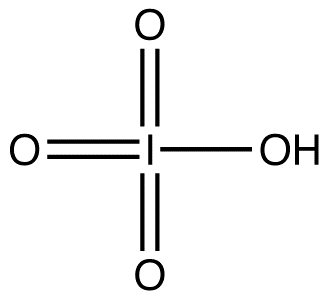Formula H5IO6 Appearance Colourless crystals | Molar mass 227.941 g/mol | |
 | ||
Periodic acid (pronounced per-iodic /ˌpɜːr.aɪˈɒdᵻk/ PURR-eye-OH-dik, rather than /ˌpɪəriˈɒdᵻk/ PEER-ee-OD-ik as in periodic table) is the highest oxoacid of iodine, in which the iodine exists in oxidation state VII. Like all periodates it can exist in two forms: orthoperiodic acid, with the chemical formula H5IO6 and metaperiodic acid, which has the formula HIO4.
Contents
- Reactions of hio4 periodic acid jee advanced mains hinglish
- Synthesis
- Properties
- Structure
- Reactions
- Other oxyacids
- References

Periodic acid was discovered by Heinrich Gustav Magnus and C. F. Ammermüller in 1833.
Reactions of hio4 periodic acid jee advanced mains hinglish
Synthesis

Modern industrial scale production involves the electrochemical oxidation of iodic acid, on a PbO2 anode, with the following standard electrode potential:
H5IO6 + H+ + 2 e− → IO−3 + 3 H2O E° = 1.6 V
Orthoperiodic acid can be dehydrated to give metaperiodic acid by heating to 100 °C
HIO4 + 2 H2O ⇌ H5IO6
Further heating to around 150 °C gives iodine pentoxide (I2O5) rather than the expected anhydride diiodine heptoxide (I2O7). Metaperiodic acid can also be prepared by from various orthoperiodates by treatment with dilute nitric acid.
H5IO6 → HIO4 + 2 H2OProperties
Orthoperiodic acid has a number of acid dissociation constants. The pKa of meta periodic acid has not been determined.
H5IO6 ⇌ H4IO−
6 + H+, pKa = 3.29H
4IO−
6 ⇌ H
3IO2−
6 + H+, pKa = 8.31H
3IO2−
6 ⇌ H
2IO3−
6 + H+, pKa = 11.60
There being two forms of periodic acid, it follows that two types of periodate salts are formed. For example, sodium metaperiodate, NaIO4, can be synthesised from HIO4 while sodium orthoperiodate, Na5IO6 can be synthesised from H5IO6.
Structure
Orthoperiodic acid forms monoclinic crystals (space group P21/n) consisting of slightly deformed IO6 octahedron interlinked via bridging hydrogens. The crystal structure of metaperiodic acid also includes IO6 octahedron, however these are connected via cis-edge-sharing with bridging oxygens to form one-dimensional infinite chains.
Reactions
Like all periodates periodic acid can be used to cleave various 1,2-difunctional compounds. Most notably periodic acid will cleave vicinal diols into two aldehyde or ketone fragments.
This can be useful in determining the structure of carbohydrates as periodic acid can be used to open saccharide rings. This process is often used in labeling saccharides with fluorescent molecules or other tags such as biotin. Because the process requires vicinal diols, periodate oxidation is often used to selectively label the 3′-termini of RNA (ribose has vicinal diols) instead of DNA as deoxyribose does not have vicinal diols.
Periodic acid is also used in as an oxidising agent of moderate strength.
Other oxyacids
Periodate is part of a series of oxyacids in which iodine can assume oxidation states of −1, +1, +3, +5, or +7. A number of neutral iodine oxides are also known.
